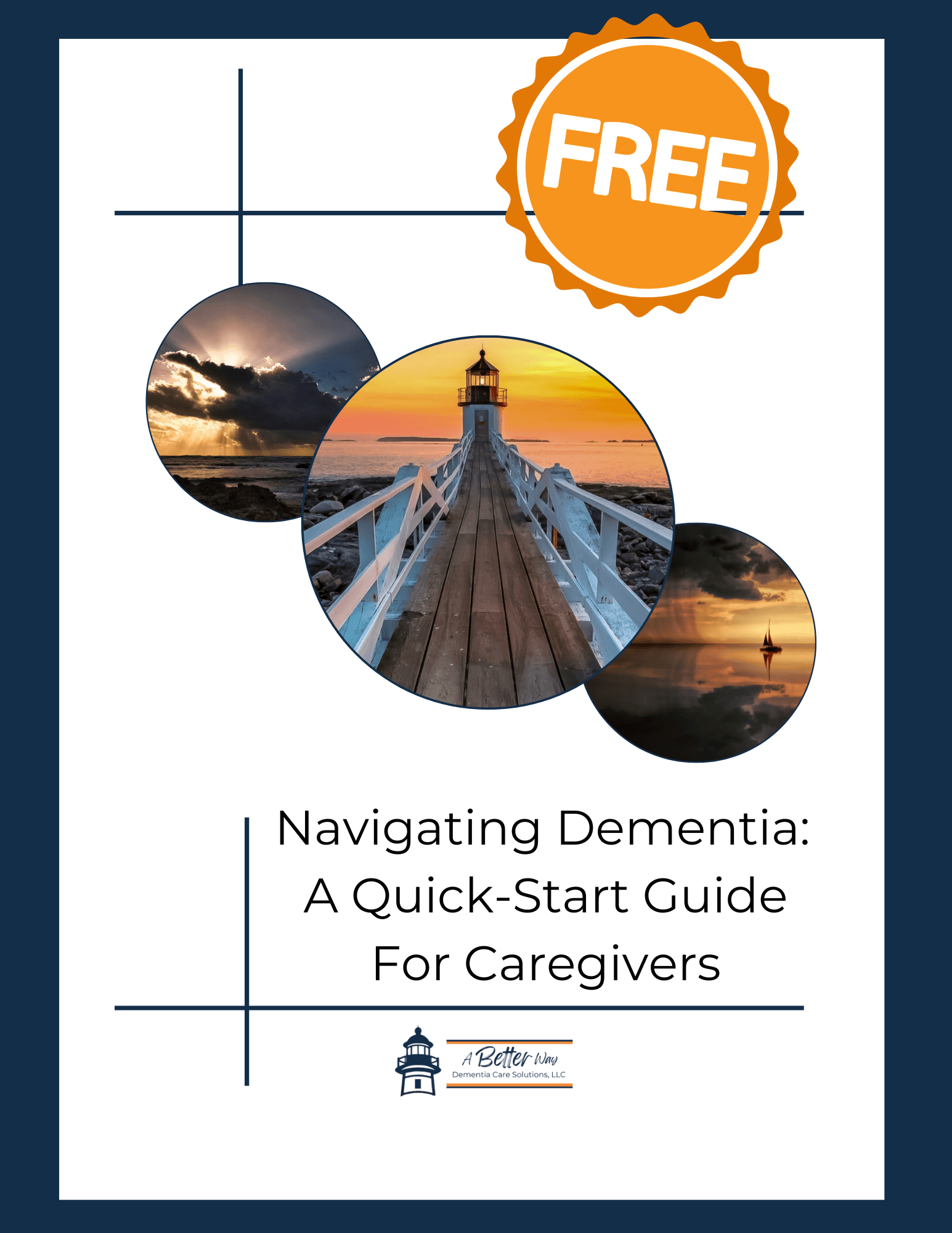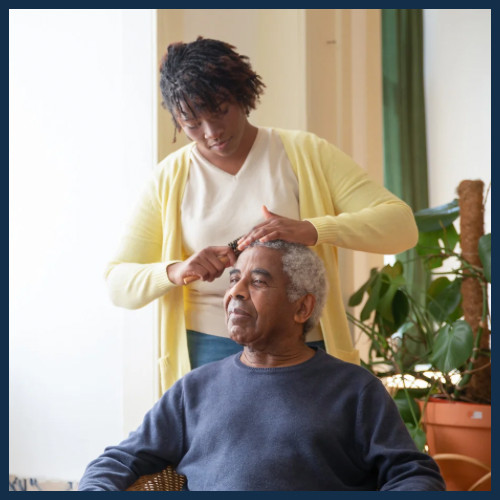
The holidays tend to arrive with a mix of joy, pressure, and uncertainty when you are caring for someone living with dementia. Many caregivers tell me they feel pulled in two directions. On one side is the desire to keep old traditions alive. On the other is the reality that things have changed. The person you care for may no longer understand those traditions, or the pace may be too overwhelming. You might be carrying grief and love at the same time.
If that is you, breathe. You are not doing anything wrong. You are doing something incredibly human. You are trying to figure out how to honor who your person is today while still holding pieces of what your family has always cherished.
This week’s post is part of our eight week holiday series, and it focuses on connection. Not picture perfect moments. Not the holiday card version of your life. We are talking about connection that feels real. Connection that feels accessible. Connection that helps your nervous system settle and helps the person you care for feel safe and included.
Why connection matters more than tradition
Traditions have history behind them. They carry nostalgia and comfort. But when dementia is part of your life, traditions can also feel complicated. What used to be fun might now be overstimulating. What used to create laughter might now lead to confusion or frustration.
It is easy to think that letting go of a tradition means letting go of your family’s identity. I understand that fear. My own family held tightly to long standing routines with my grandparents even after those routines stopped making sense. We were trying to protect something, but in the process we missed opportunities to create moments that actually worked for where they were in the disease.
Connection does not need to be tied to the past. It can grow right here. Today. In the life you are living now. When you shift the pressure away from recreating old memories, you open space to notice what feels good in this season of life.
Start with your person’s current abilities
If you take nothing else from this post, take this. Connection is built on who your person is today, not who they used to be.
Look at what they can still do comfortably. Look at what brings them joy. Look at what overwhelms them. Their abilities are the foundation for any holiday activity. When you match your expectations to their current strengths, you both feel more settled.
You can ask yourself:
What helps them feel calm
What seems to cause stress
How do they respond to noise
How long can they stay engaged
What time of day works best
Your answers guide you. They help you design a holiday rhythm that supports connection rather than pushing through activities that no longer fit.
The power of slowing down
Caregivers often feel pressure to keep up with the pace of the season. But rushing and connection rarely go together, especially when dementia is part of the picture.
Slowing down is not giving up. Slowing down is choosing something that works better.
Sometimes the slowing down starts in the quiet. It can be a calm moment by the water with a warm drink in your hand. It can be a few minutes on the porch while the air settles around you. It can be a simple pause at your kitchen table before the day begins. It can even be sitting in front of the tree watching the lights twinkle while everything else feels loud. These moments remind you that you are still a person with needs, not only a caregiver trying to hold everything together.
Slow down during meals.
Slow down during conversations.
Slow down during transitions.
When you loosen the pace, you create space for presence. You allow your person to join the moment in their own way. You also give yourself permission to notice what feels good instead of fighting what used to work.
Choosing moments over memories
This is hard for a lot of caregivers. Holidays are often defined by memories. Photos, stories, traditions, the things people talk about for years. Dementia changes how memory works, but it does not erase the ability to feel.
Your person may not remember the gift you gave them or the dessert you made. But they can feel warmth. They can feel comfort. They can feel belonging. They can feel safety.
When you shift the goal from creating memories to creating feelings, everything gets simpler. You release yourself from the pressure to make the holiday memorable and instead focus on making it meaningful.
Practical ways to build connection this season
Here are grounded, simple ways caregivers can foster real connection. None of this requires elaborate planning. Use what fits. Skip what does not.
Shared sensory experiences
Sensory connection is often easier than cognitive connection.
Try things like:
Soft holiday music
Warm blankets
Twinkle lights
A scented candle if safe
A favorite snack
Hand lotion with a gentle scent
A familiar ornament to hold
These things create comfort without needing conversation or recall.
Short and simple activities
Think five to ten minutes. Enough time to engage but not enough to overwhelm.
Ideas include:
Stirring cookie dough
Watering a small plant
Looking at holiday cards
Sorting ribbons by color
Watching a short holiday video
Folding napkins for the table
Activities that support dignity matter. Even small tasks help someone feel part of the day.
Connection through familiar rhythms
Routines feel grounding. Keep your person’s usual daily structure as much as possible even when guests arrive.
Same wake time
Same meal times
Same rest times
Same calm evening routine
Holidays can fit around the rhythm instead of replacing it.
Supporting connection during gatherings
Family gatherings can be tricky when dementia is involved. You want your person included. You also want everyone else to understand what they need. Here are a few ways to support a smoother day.
Keep the environment calm
Set up a quiet place away from noise where your person can retreat if they feel overwhelmed. This might be a bedroom, den, or corner with a comfortable chair.
Prepare family members
A quick conversation can help. Let them know what helps your person feel safe and what tends to cause stress. You are not asking them to lower their expectations. You are helping them adjust so everyone can enjoy the time together.
Keep introductions simple
If someone does not remember a family member, offer gentle support. Something like, “This is Sarah. She is happy to see you.” You do not need to quiz anyone. You are not testing memory. You are setting them up to feel successful.
When emotions come up
Caregivers often feel sadness during the holidays. You might notice the changes more clearly. You might miss the way things used to look. You might feel guilty for wanting quiet when everyone expects joy.
None of these feelings mean you are failing. They mean you are human.
Give yourself permission to feel what you feel. It will not take away from your ability to show up. If anything, it helps you show up more honestly.
What helps here:
Taking a brief walk
Stepping outside for fresh air
Calling a supportive friend
Doing a short breathing pause
Letting yourself cry if you need to
You cannot carry holiday expectations and heavy emotions at the same time without breaking somewhere in the middle.
What you can let go of this year
You are not responsible for managing everyone’s expectations. You are responsible for creating a holiday that supports your person’s abilities and protects your energy.
You can let go of:
Large gatherings
Long events
Complex meals
Old traditions that no longer work
Pleasing everyone else
Comparing this year to the past
Letting go is not failure. Letting go is making space for what works now.
What truly matters
Connection. Not perfection. Not performance. Not pressure.
Connection built through:
Warmth
Gentle presence
Simple moments
Shared sensory experiences
Honest expectations
Respect for your person’s stage of dementia
Compassion for yourself
When you center these things, the holiday becomes calmer and more meaningful for both of you.
A gentle reminder for you
You are carrying a lot. You are doing the work of coordinating, protecting, adjusting, and caring. You make decisions every day that most people will never see. You deserve moments of quiet and comfort too. You deserve your own connection, not only with the person you care for, but with yourself.
If you want more support, more guidance, or more community this season, you can get my weekly blog delivered right to your inbox. Just comment the word BLOG and I will come straight to you along with the free holiday checklist.
You are doing good work. You are not alone in this.
Want to keep figuring this out together?
Subscribe to Finding Our Way in Dementia Care and get honest stories, helpful tips, and gentle support delivered to your inbox every week. Just real talk, grounded care, and space to breathe.
Subscribe to Finding Our Way in Dementia Care and get honest stories, helpful tips, and gentle support delivered to your inbox every week. Just real talk, grounded care, and space to breathe.
Kind truth. Clear steps. Warm guide.
















0 Comments